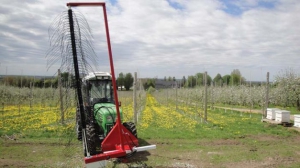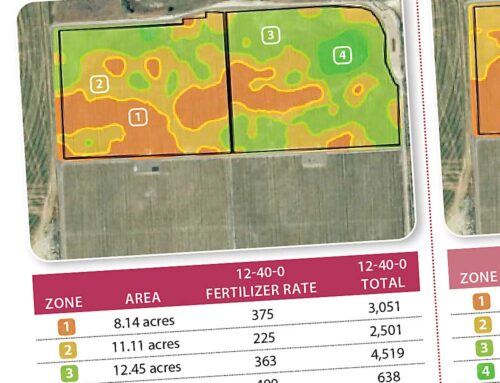
A tractor mounted Darwin thinning device. (file photo)
Mechanical thinning looks like a promising technique for reducing the amount of labor-intensive hand thinning required in order to grow a good crop of nice-sized apples.
That’s the conclusion reached by a team of researchers from around the country who worked on a major project to evaluate mechanical thinning. For their project, they tested a couple of thinning machines—the Darwin and the Uni Bonn string thinners, both of which originated in Europe. (See 2011 Good Fruit Grower story about the Darwin)
The machines, which have rotating spindles with ropes or strings attached, are designed to knock flowers off the trees, but they can also remove spurs and damage leaf tissue.
This got Tory Schmidt, research associate with the Washington Tree Fruit Research Commission, wondering how mechanical thinning might affect a tree’s fruit production in the long term.
“We know we get good thinning with the Darwin, but if you continue to beat up the canopy and knock off the spurs every year, does that have a long-term detrimental effect on the bearing surface?” he wondered.
“I had always been bothered by seeing all the spurs left on the ground after a mechanized thinner goes through,” he said. “It’s always been a question that was nagging me.”
So, three seasons ago, Schmidt began a project in a block of Granny Smith apples at Washington State University’s Sunrise research orchard near Wenatchee, to find the answer.
Three treatments
He’s comparing three different treatments:
—The standard chemical thinning program of two applications of fish oil and lime sulfur during bloom followed by one application of a bloom thinner
—Mechanical thinning with the Darwin
—Chemical thinning and mechanical thinning on alternate years (beginning with mechanical in the first year of the trial)
Schmidt wants to see two to three more years of data, but early indications are that potential yields in the mechanically thinned block have dropped off. Bloom density decreased from 9.2 flower clusters per square centimeter of trunk cross-sectional area the first year to 6.0 the second year, and only 2.7 in the spring of 2013.
In comparison, bloom density in the chemical treatment went from 8.9 clusters per square centimeter the first year, to 2.5 the second year, but up to 3.9 clusters last year.
In the alternating treatment, the flower clusters went from 6.3 to 4.1 to 4.0.
“In the mechanized thinning treatment, we’re concerned that the bloom density has gone down every year,” he said.
Schmidt said it remains to be seen if this is a trend or just a temporary downtick. •






Leave A Comment